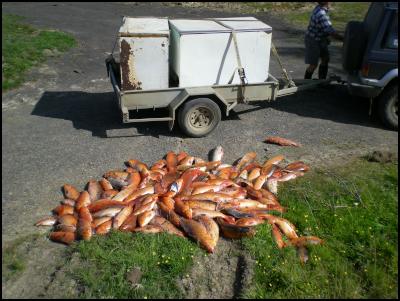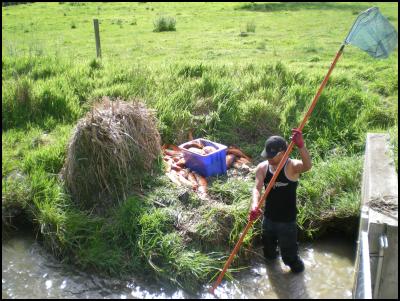Koi Carp Trap Trial Successful at Lake Waikare
MEDIA RELEASE
18 November 2010
Koi Carp Trap Trial Successful at Lake Waikare
A trial of a koi carp trap at Lake Waikare has proved successful with more than 1500 kilograms of fish caught.
The trial of the equipment was undertaken because pest fish, including koi carp, are a major problem in the Waikato River.

Click for big version
They are believed to be a major contributor to the decline of water quality in the region’s rivers and lakes.
Pest fish generally have been linked to the collapse of aquatic plants, loss of native biodiversity, algal blooms and reduced waterfowl production.
In 2007 and 2008 a University of Waikato PhD study was conducted to examine the movements of koi carp throughout the lower Waikato River basin.
One of the primary objectives of this research was to identify key environmental variables triggering koi movement and to determine primary migration routes that could be targeted in the future for effective point source control of this species.
This study, co-funded by the Department of Conservation (DOC), Environment Waikato (EW) and the Pest Fish Outcome Based Initiative (OBI), revealed that large numbers of koi carp regularly undertake movements between the Waikato River and connected shallow riverine lakes.
In June this year, EW invited two Australian carp researchers from the South Australian Research and Development Institute (SARDI) to a three day think tank session and field trip to devise a programme for point source control of carp.

Click for big version
Regional pest fish managers - including staff from EW, DoC, the Ngaa Muka Development Trust and Waikato-Tainui - attended the session.
The outcome from this workshop was a decision to test an innovative koi push trap designed by SARDI at the Lake Waikare fish pass, a location known from previous university research to be an important migration route for carp.
Funding to construct and install the trap was obtained by the Ngaa Muka Development Trust through a grant from the Waikato District Council. The trap, based largely on the SARDI design, was constructed with minor modifications by Jackson Engineering of Te Kauwhata and installed in the Lake Waikare fish pass in August this year.
The trap became fully operational by November 2010 and proved to be highly effective. Staff from the University of Waikato, EW and the Ngaa Muka Development Trust removed an estimated 1565 kg of koi carp (777 fish) from the trap over two and a half days (233 koi carp per day) with minimal by-catch of native fish. “The result has exceeded the expectations of all involved,” said EW biosecurity officer Dave Byers
EW freshwater scientist Dr Bruno David, who initiated the trial project, said: “The success of the experimental trap is very encouraging and will likely lead to the development of a proposal to install a permanent automated koi trap in the Lake Waikare fish pass.”
University of Waikato researcher Dr Adam Daniel who undertook the original carp movement research believes that: “This concept could be adapted to control fish in many of the Waikato region’s lakes and wetlands where koi carp have dominated the fish biomass for decades.
“The ultimate goal of this multi-agency collaboration will be to reduce and evaluate the impacts of carp on water bodies in the lower Waikato basin which are under stress from a multitude of sources.”
ENDS


 Gordon Campbell: On The New Pope, And The Israeli Attack On Peter Davis
Gordon Campbell: On The New Pope, And The Israeli Attack On Peter Davis Transport Accident Investigation Commission: Near-Collision Highlights Safety Lessons For All Busy, Unattended Aerodromes
Transport Accident Investigation Commission: Near-Collision Highlights Safety Lessons For All Busy, Unattended Aerodromes Green Party: Wildlife Law Change A Deep Betrayal Of Public Trust
Green Party: Wildlife Law Change A Deep Betrayal Of Public Trust NZCTU: Unions Launch Petition To Protect Pay Equity
NZCTU: Unions Launch Petition To Protect Pay Equity Greenpeace: Greenpeace Slams PM’s Science Pick - 'Polluters Are Running The Show'
Greenpeace: Greenpeace Slams PM’s Science Pick - 'Polluters Are Running The Show' NZ Government: PM’s Science Prizes Celebrate Excellence
NZ Government: PM’s Science Prizes Celebrate Excellence Department of Conservation: Pinnacles Hut, Summit Track Set For Improvement
Department of Conservation: Pinnacles Hut, Summit Track Set For Improvement 


